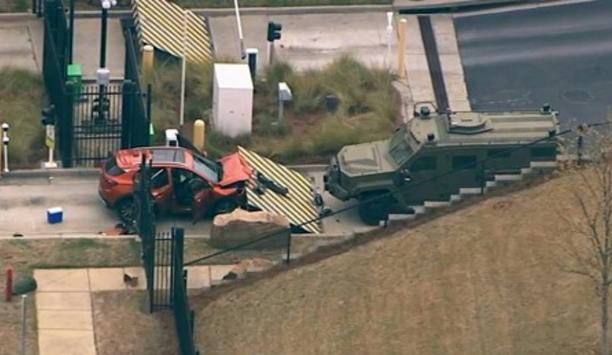Before 9-11, perimeter security was used to provide an extra barrier of protection for an airport and its people typically from hijackers and vandals. Although that is still true today, there is now an added threat. In our present environment, we cannot afford to let a terrorist or deranged attacker get near our airport facilities, people or passengers. In all too many cases, getting near is all they have to do.
Though every effort is made to ensure the safety of air travellers, what is being done to protect those that work within the airports? What about the security of the cargo delivered? What about perimeter security breaches – allowing possibly dangerous terrorists and criminals onto federal aviation property, thereby endangering everyone within? Airports throughout the world are now taking measures to protect everyone, passengers and employees, by installing vehicle access control devices. These new airport security systems are designed to stop anyone driving any type of vehicle.
Originally used primarily to stop the constant risk of thefts at car rental agencies, bollards, barriers, barricades and crash gates are now common throughout airports, especially after 9-11. Booths were traditionally used for housing guards who collected parking fees. Today, they’re often ballistic rated. From protecting the tarmac to passenger areas, airports today are especially conscious of controlling vehicle access.
As a countermeasure to increased theft of rental cars approximately 15 years ago, many rental car operators began using traffic controllers to disable unauthorised vehicles from entering or leaving their lots. Installation of these units all but eliminates drive or crash out thefts.
Over 120 other car rental lots around the globe have installed some variety of vehicle access control systems. The motorised traffic controllers (the “wrong-way” teeth), warning signs and traffic and surface mounted controllers (i.e. gates) together prevent thefts of rental cars by disabling unauthorised vehicles from entering or leaving the lot.
Almost every airport features parking/cashier booths. Some are fairly basic; others are upgraded. For instance, on the way out of the Minneapolis/St. Paul International Airport 18 prefabricated Delta parking/cashier booths help handle the airport’s doubled parking capacity of 13,000 spaces. Put in prior to 9-11, these booths are simultaneously aesthetically pleasing and contribute to the overall security of the airport by providing vehicle access control. The rounded corners and custom painted design complement their two 9-level parking structures. Two heaters, double insulation and tinted glass help parking attendants to guard against both the Minnesota winters and sun.
Contrast them with the bullet resistant level 4 booths used at California’s Ontario Airport. These 22x4 meter buildings were manufactured to meet tight specification requirements, including structural calculations and wet seals from drawings by a Registered California Structural Engineer.
Types of systems being used
The ramp up in guard booths illustrates the increased security measures airports now take with vehicle control. Soon after 9-11, the United States Air Force began deploying very high security DSC501 barriers at its facilities around the globe. The DSC501 barricade will stop and destroy a 48,484 kg vehicle traveling 80 kph. Such barricades can be raised or lowered at will to stop traffic or let it through. In an emergency, the thick steel plates or bollards pop out of the ground within 1.5 seconds. Commercial airports followed suit.
This barricade was originally designed for the U.S. Navy and has also been selected for use at U.S. Embassies. Set in a foundation only 45.7 cm deep, the Delta DSC501 is able to survive after a 5.4 million foot pound impact.
With the DSC 600 bollard modules, |
With its shallow foundation, it obviates the concerns of interference with buried pipes, power lines and fibre optic communication lines, a major consideration at airports. The shallow foundation also reduces installation complexity, time, materials and corresponding costs. Front face warning lights warn drivers that the barricade is in the “up” position. There is also an open area on the front for signage. Diagonal yellow and white stripes are standard and optional colours and graphics are available. The open channel construction even lets airports specify hot dip galvanising.
Crash gates. Among the many U.S. FAA mandates airports must meet is one that requires securing access points to international freight lines. That includes access to air cargo facilities, where scores of trucks must go in and out on an hourly basis. That was the issue facing California’s largest fencing contractor, Alcorn Fence, at Los Angeles International Airport (LAX) for Qantas and Singapore Airlines.
The sliding gate system that is used in such an application must be crash rated. Clear openings range from 4 to 10 metres. A linear crash gate will withstand the impact of a 6,803 kg vehicle striking the gate at 8 kph. To solve the problem, Alcorn Fence installed crash-tested swing gates on the runway that accesses the cargo facilities. The SCG1000 provides openings of up to 40 feet and the gates can be up to nine feet tall. Best of all no ground tracks are required, keeping installation costs to a minimum while protecting the integrity of the runway. These gates can be seen at LAX on the runway accessing the Singapore Airlines and Qantas Airlines terminals.
LAX additionally uses the SC3000 industrial gate in various places. This gate, like the SGC 1000, doesn't need a track, wheels or roller path across the entrance or drive it protects. Thus, it adapts well to roads with high crowns, drainage gutters or other conditions that preclude ground tracks.
Bollards – moveable and fixed
Aesthetics should not be overlooked. With today's smart designs, it's no longer necessary to choose between form and function. Airports can have them both. Designers are creating secure environments with more compatible and aesthetically pleasing architectural elements. With bollards, airports can create the look they want. Ranging from faceted, fluted, tapered, rings and ripples, colours, pillars, to shields, emblems and logos, bollards are aesthetically pleasing and versatile. In other words, they dress up airport security.
Bollard systems operate individually or in groups up to ten and are used for intermediate level security applications. Individual bollards are up to 33.65 cm in diameter, up to 88.9 cm high and are usually mounted on 1-metre centres. Hydraulic and pneumatic versions can be operated by a variety of control systems. Manual versions are counter balanced and lock in the up or down position. All models are crash rated and lower to allow passage of authorised vehicles.
The incident at Glasgow International Airport on June 30, 2007, raised new concerns for airports. The airport was evacuated after a green Jeep Cherokee struck the airport's terminal building and burst into flames.
In such cases, a cost effective fixed bollard array can be used instead of retractable bollards. However, airport infrastructures exacerbate installation problems caused by rough surfaces, turns, and lack of traditional foundation depth due to subsurface utilities and fibre optics, among others. Moreover, conventional barriers require surface areas to be completely level. Given the growing demand for a crash-resistant device that is easy to install, attractive, yet compliant with restrictive subsurface conditions, the DSC 600 Shallow Foundation Bollard was recently introduced.
Traditionally on curves, setbacks often end up too close to the facility. Now, airports can install bollards on the upper levels of parking structures and other unprotected facilities without using unsightly ‘make-do’ solutions to stop car bombers or negligent drivers.
New DSC 600 Shallow Foundation Bollards will protect approaches to airport facilities, drop-off and passenger loading areas at transportation hubs and other presently unprotected locations where unauthorised vehicle intruders have no obstacles to stop them. With the DSC 600 bollard modules, those facilities surrounded by streets, abutting sidewalks and set back on lawns can now be effectively protected. The new DSC 600 bollards will blend into curves, rough terrain or inclines easily. Setbacks can be as short as two feet, providing a much greater safety cushion for the airport facility.
With a foundation only 35.6 cm deep versus the 122 cm typically required, Shallow Foundation Bollards can be installed within sidewalks, on top of concrete deck truss bridges or in planters as well as conform to the inclines and turns of a locale. The new 2-bollard modules, which can be arrayed in whatever length is required, will stop and destroy a 6,803 kg truck traveling 80 kph.
Bollard systems operate individually |
They have already successfully passed a K12 rating crash test, providing proof of their ability to provide high-energy stops. In fact, the DSC 600 is the first Shallow Foundation Bollard to successfully meet the U.S. Department of State Specification, Revision A that requires the bed of the attacking truck to go less than 99 cm beyond the point of impact.
The new bollard modules also meet the 1-meter clearance regulations mandated by the Americans with Disabilities Act (ADA). Although the DSC 600 bollards will let people pass through them, they will stop vehicles dead in their tracks.
Slow down vehicles
Because of the relationship of velocity to the total kinetic energy possessed by a vehicle, airports typically force a vehicle to slow down before it reaches the bollard, or any other barrier in fact. The most frequently used technique is to require a sharp turn immediately in front of the barrier. When vehicle speed is reduced by 50 percent, the "hitting power" is reduced by four times. If the speed is reduced by 2/3rds, the force of impact will be reduced by nine times.
Upon designing a way to slow down vehicle approach, they also assure that the attacking car cannot make a "corner cutting shot" at a barricade. Often, only a light post defines a turning point and a speeding car can take it out and not even hesitate. Knolls and other impediments are typically employed.
Airports on the forefront of vehicle access control
By their very nature, terrorist attacks are unpredictable and predicated on surprise. Staying one step ahead by identifying vulnerable areas, and securing them, is critical to staving off vehicular attacks. Terrorists typically don't go where they see barricades, so placing them wherever possible attacks can happen reduces security risks dramatically.

















